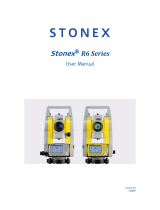
CONTENTS
iii
14. SETTING-OUT MEASUREMENT . . . . . . . . . . . . . . . 50
14.1 Distance Setting-out Measurement . . . . . . . . . . 51
14.2 Coordinates Setting-out Measurement . . . . . . . 54
14.3 REM Setting-out Measurement . . . . . . . . . . . . . 56
15. OFFSET MEASUREMENT . . . . . . . . . . . . . . . . . . . . 59
15.1 Single-distance Offset Measurement . . . . . . . . 59
15.2 Angle Offset Measurement . . . . . . . . . . . . . . . . 61
15.3 Two-distance Offset Measurement . . . . . . . . . . 63
16. MISSING LINE MEASUREMENT . . . . . . . . . . . . . . . 66
16.1 Measuring the Distance between 2 or more Points
. . . . . . . . . . . . . . . . . . . . . . . . . . . . . . . . . . . . . . 66
16.2 Changing the Starting Point. . . . . . . . . . . . . . . . 68
17. Recording Data - REC Menu - . . . . . . . . . . . . . . . . . . 69
17.1 Recording Distance Measurement Data . . . . . . 69
17.2 Recording Angle Measurement Data . . . . . . . . 71
17.3 Recording Coordinate Data . . . . . . . . . . . . . . . . 72
17.4 Recording Instrument Station Data . . . . . . . . . . 73
17.5 Recording Notes . . . . . . . . . . . . . . . . . . . . . . . . 75
17.6 Reviewing Job Data. . . . . . . . . . . . . . . . . . . . . . 76
18. SELECTING/DELETING A JOB . . . . . . . . . . . . . . . . 78
18.1 Selecting a JOB. . . . . . . . . . . . . . . . . . . . . . . . . 78
18.2 Deleting a JOB . . . . . . . . . . . . . . . . . . . . . . . . . 79
18.3 Outputting JOB Data to a Host Computer . . . . . 80
19. REGISTERING/DELETING DATA . . . . . . . . . . . . . . . 83
19.1 Registering/Deleting Known Point Data . . . . . . 83
19.2 Reviewing Known Point Data . . . . . . . . . . . . . . 86
19.3 Registering / Deleting Codes . . . . . . . . . . . . . . 87
19.4 Reviewing Codes. . . . . . . . . . . . . . . . . . . . . . . . 89
20. CHANGING THE SETTINGS . . . . . . . . . . . . . . . . . . . 90
20.1 EDM Settings . . . . . . . . . . . . . . . . . . . . . . . . . . 90
20.2 Configuration -Config. Mode- . . . . . . . . . . . . . . 92
20.3 Allocating Key Functions -Config. Mode- . . . . . 96
21. RESTORING SET ITEMS TO INITIAL SETTINGS . 101
22. WARNING AND ERROR MESSAGES . . . . . . . . . . 102
MEASURE-
MENT
-MEASURE-
MENT
MODE -
MANAGING THE
DATA
-MEMORY
MODE-
ADDITIONAL
DETAILS
SET2120TOC.fm iii ページ 2003年3月6日 木曜日 午前11時45分
























